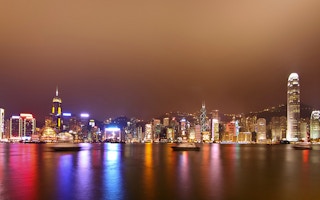As Typhoon Nida began to form off Hong Kong’s coastline last month, Leung Cheuk-lun, an engineer with the city’s Drainage Services Department, quietly slipped into an underground bunker beneath some football pitches in the city’s Happy Valley district.
The pitches lie between steep hills to the south, and densely-packed, harbor-side, shiny skyscrapers to the north. The cavernous, water-storage bunker below, which resembles a giant underground carpark and was completed a few months ago, was designed for days when stormwater rushes down from the hills toward Victoria Harbour through a drainage culvert, often while waves lash from the other direction.
During heavy rain events stormwater is automatically diverted from the culvert to the tank, Leung explained, and the city’s drainage engineers follow the action through a smartphone App. “Everything is in real time,” he said proudly of the US$137 million (909 million yuan) system, which was designed to handle 50-year rainstorms. “That will help us a lot just in case of any emergency out there.”
But despite this and other recent investments in Hong Kong’s flood-control infrastructure, climate change experts wonder how well this low-lying, semi-autonomous Chinese territory and global financial centre is preparing for the climate-related impacts that will surely affect its seven million people and physical infrastructure in future decades.
The Hong Kong government prides itself on its tech-savvy, hyper-efficient approach to municipal governance, and it has commissioned several related studies to assess climate change.
It issued a 122-page report last year, for example, detailing its climate mitigation and adaptation efforts and longer-term plans; and in April it launched a citywide climate-change commission tasked with coordinating department-level efforts to reduce greenhouse gas emissions and prepare for climate-related impacts.
But some climate change experts wonder if the government can muster the political will needed to coordinate a multi-faceted response that engages the city’s powerful business community on mitigation efforts; educates the public about climate-related risks; and makes bold planning decisions with an eye on worst-case scenarios.
“
If sea level continues to rise, then sooner or later there will be a chance of a big wave hitting the buildings.
Tong Hai Wai, scientific officer, Hong Kong Observatory
“It’s very hard for [the Hong Kong authorities] to change standard operating procedures,” said Paul G. Harris, a professor of Global and Environmental Studies at the Education University of Hong Kong.
“Officials will give you long lists of things they are doing, but all you need to do is walk around and see that it’s almost meaningless,” added Harris, the author of What’s Wrong with Climate Politics and How to Fix It. “For example, you will see buildings going up just a few feet above current sea level.”
Like other coastal megacities, Hong Kong faces multiple climate-related threats, including sea-level rise, intensifying storms, rising temperatures and the possibility of severe floods and droughts.
But Hong Kong’s location and physical features present particular challenges. The city is regularly battered by typhoons and its dense urban grid traps heat and makes sweltering street-level temperatures even hotter. Average July temperatures are 28.7C, and a further increase in temperatures is a potential health risk, officials say, especially for people who live in tiny apartments without air conditioning.
Because Hong Kong’s urban centres are bordered by sea on one side, and tall hills on the other, engineers like Leung have long worked to prevent waves and rainwater from damaging buildings, flooding metro tunnels and causing landslides on the steep hillsides that border many neighbourhoods.
Tong Hai Wai, a scientific officer at the government-run Hong Kong Observatory, which makes weather and climate forecasts, said in an interview that all of those factors are worrying. But he said the biggest concern is that rising sea levels may exacerbate the damage caused by storm surges during tropical cyclones (which typically occur between June and October).
Hong Kong last witnessed that combination in a serious way in 2008, he said, when a storm surge caused major flooding in the seaside village of Tai O. The Observatory currently predicts that flooding of that scale will happen every 50 years, but Tong said it could happen yearly if global sea levels rise by a meter by the end of the century — one of several scenarios forecasted by the Intergovernmental Panel on Climate Change (IPCC).
Architects and planners are already taking climate change forecasts into account for building projects in Hong Kong, Tong said: “However, if sea level continues to rise, then sooner or later there will be a chance of a big wave hitting the buildings.”
This story was originally published by Chinadialogue under a Creative Commons’ License and was republished with permission.
Read the full story.










